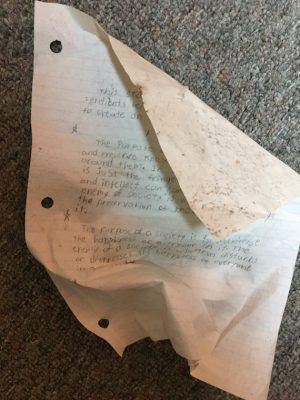After a recent evening rainstorm, I went walking by the Mississippi River near my home and found a handwritten start of a paper clearly written by a young person. The college-ruled sheet was water-stained, brown and wrinkled, but the writing in pencil was very clear and exact.
This single sheet of paper was starred a couple of times throughout and, in the introductory paragraph, shared that the assignment attached was about the vision to create an ideal, conflict-free society here on earth. Unfortunately for me, the rest of the paper was not attached as I would have loved to read more. But luckily for this student all their thoughts and hard work didn’t need to be redone.

As you might have guessed, I was intrigued by the topic this student was writing about due to all the issues, challenges, press and demonstrations that have been inundating us lately about who, according to some individuals, supposedly belongs and is welcome as part of our neighborhood, our community, our city, our country and our world.
The paper noted: “The purpose of a society is to collect and preserve the knowledge about the world and the people around them. In this context, the world is just the fringe of what our senses and intellect can comprehend. The purpose of a society is therefore to maximize the happiness of everyone in it” (author unknown).
Wow! I immediately thought, I wonder what our present society is looking like in the eyes of this young person? What about in the eyes of my own four children? Do they see what I see? Are they seeing the pain in the faces of those facing discrimination, hurtful words and actions? Are they feeling the sadness of whole communities of people being obliterated through war, hunger and natural disasters? Are they hearing the cries of the families being separated because they might not have the “right” documentation? Are they sensing the physical and emotional coldness of others around them because of differences in dress, religious practices and other native languages spoken? This is what I see. This is what I feel. This is what I hear. This is what I sense.
Though this was just a simple piece of paper I found by chance one day with a few thoughts and ideas collected on it, the message is very clear and quite profound.
What would our world look like if we took the lead from these young people? It is revealing how a young person — without as much time here on earth and years of experience we adults have — has the wisdom and understands the importance of being attentive to the people around them and inevitably finding happiness for themselves and others by this awareness.
I marvel at how children and youth — because they are so often exposed to friends of different cultures, colors, religions, languages — have the ability to “see” this friend of theirs through eyes of nearly complete and total acceptance. They are willing to learn, through trial and error, about the world and the people around them. They appear to be seeking happiness for themselves and for others in these friendships and relationships. They are seeking to be a part of a society that maximizes in whatever way possible the happiness of all.
Elizabeth Neville is director of the St. Cloud Mission Office, 11-8th Ave., St. Cloud.






















